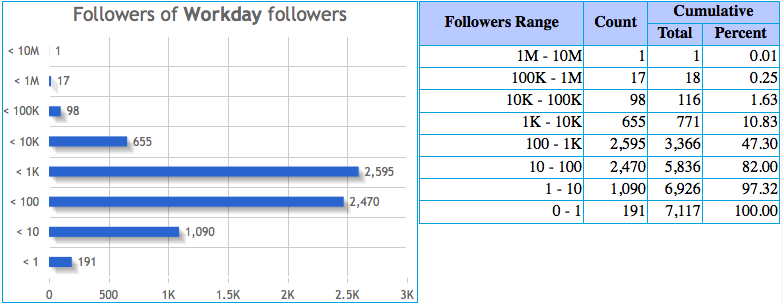As the proverb goes enemy’s enemy is my friend, it doesn’t have to be that way with Social Networks. For companies spending lots of marketing money on Social Networks, one of their main goal is to amass as many followers as possible. However, it’s a good idea to analyze which of your followers can potentially help you get more followers. Most social networks typically have streams or the wall or whatever you call it for each user and the user’s friends and/or followers can see what the user is talking about. So, if you have a follower who has lots of followers, then there is a good chance that more people will become aware of you. This is actually called the network effect. Your network is not just the immediate set of people you follow/friends with but their friends/followers and their network and so on. Obviously, the effect is going to taper of as the degree of separation increases.
It’s usually not practical to analyze the entire network effect due to the lack of information available. The public APIs available from Social Networks typically come with restrictions on the rate of API calls (and for a good reason) and hence everyone other than these networks are constrained by the amount of data available to them.
In this post, we will research on the level two followers distribution for the cloud companies we looked at in the previous post on rate of building the social network. Following is based on data from Twitter.
In the above data for Salesforce, we see that they have 3 followers who themselves have more than a million followers! Imagine if just these three followers talk about Salesforce! Salesforce actually has 53.37% of followers who themselves have at least 100 followers.
The above data is for Workday. They just have one follower with more than a million followers. Similarly, they have less than 50% of people with more than 100 followers. However, the percent of people with more than 1K followers is more than that of Salesforce. This distribution of level 1 followers by their own followers provides insight into the overall network effect. That is, if two companies have similar number of followers, but if one of them have more followers with higher number of followers, then that company is likely to have a larger reach.
Finally, this is the level 1 followers distribution for Oracle Cloud Zone. They are yet to get twitter followers who have more than a million followers. At present they also have only 40% followers with 1K or more followers. Again, given the time frame these three accounts have been on twitter, it’s not an apples to apples comparison, but it should provide insight to each of these account managers how their network is growing.
Given the network effort, should a certain percent of the budget be dedicated towards the high profile followers who themselves have lots of followers? May be like 40% of the budget towards top 10% followers? I just play with data, not actually manage any such accounts. So, would like to hear from others who actually do that as a job and what they think of such type of analysis on their network.



